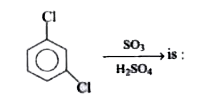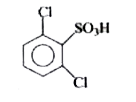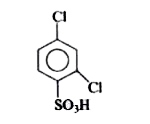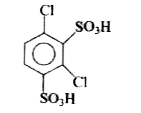Cyanogen gas is obtained in the reaction
CuSO4(aq)+KCN→
K4[Fe(CN)6]heat−−→
CH3CN+H2OΔ−−→
CH3CONH2+P2O5Δ−−→
The correct Answer is:A
To determine which reaction produces cyanogen gas, let's analyze the given reactions step by step.
Step 1: Analyze the first reaction
Reaction: Copper sulfate (CuSO4) reacts with potassium cyanide (KCN).
Balanced Equation:
CuSO4+4KCN→2CuCN+K2SO4
Decomposition:
Copper(I) cyanide (CuCN) is unstable and will decompose:
2CuCN→2Cu+C2N2
Conclusion: This reaction produces cyanogen gas (C2N2).
Step 2: Analyze the second reaction
Reaction: Potassium ferrocyanide (K4(Fe(CN)6)) is heated.
Products: Heating in concentrated H2SO4 produces carbon monoxide (CO) and in dilute H2SO4 produces hydrogen cyanide (HCN).
Conclusion: No cyanogen gas is produced in this reaction.
Step 3: Analyze the third reaction
Reaction: Acetonitrile (CH3CN) is heated with water (H2O).
Products: This reaction produces acetic acid (CH3COOH) and ammonia (NH3).
Conclusion: No cyanogen gas is produced in this reaction.
Step 4: Analyze the fourth reaction
Reaction: Acetamide (CH3CONH2) reacts with phosphorus pentoxide (P2O5).
Products: This reaction leads to the formation of cyanide (CH3C≡N).
Conclusion: No cyanogen gas is produced in this reaction.
Final Conclusion
The only reaction that produces cyanogen gas is the first one, where copper sulfate reacts with potassium cyanide. The cyanogen gas is formed due to the decomposition of copper(I) cyanide.
Summary of Steps:
1. First Reaction: Copper sulfate + KCN → CuCN (unstable) → Cu + Cyanogen gas (C2N2) ✔️
2. Second Reaction: K4(Fe(CN)6) + H2SO4 → CO or HCN (no cyanogen) ❌
3. Third Reaction: CH3CN + H2O → CH3COOH + NH3 (no cyanogen) ❌
4. Fourth Reaction: CH3CONH2 + P2O5 → CH3C≡N (no cyanogen) ❌
Reaction: Copper sulfate (CuSO4) reacts with potassium cyanide (KCN).
CuSO4+4KCN→2CuCN+K2SO4
Copper(I) cyanide (CuCN) is unstable and will decompose:
2CuCN→2Cu+C2N2
Reaction: Potassium ferrocyanide (K4(Fe(CN)6)) is heated.
Reaction: Acetonitrile (CH3CN) is heated with water (H2O).
Reaction: Acetamide (CH3CONH2) reacts with phosphorus pentoxide (P2O5).
The only reaction that produces cyanogen gas is the first one, where copper sulfate reacts with potassium cyanide. The cyanogen gas is formed due to the decomposition of copper(I) cyanide.
1. First Reaction: Copper sulfate + KCN → CuCN (unstable) → Cu + Cyanogen gas (C2N2) ✔️
2. Second Reaction: K4(Fe(CN)6) + H2SO4 → CO or HCN (no cyanogen) ❌
3. Third Reaction: CH3CN + H2O → CH3COOH + NH3 (no cyanogen) ❌
4. Fourth Reaction: CH3CONH2 + P2O5 → CH3C≡N (no cyanogen) ❌
Similar Questions
Knowledge Check
Find the correct statements regarding the methyl glucosides obtained by the reaction of D-Glucose with methanol in presence of dry HCl gas.
AThese are methyl ether of hemiacetal of glucose formed by intramolecular reaction.BThese are enantiomers.CThese are anomers.DIn one of these all the substituents are equatorial.The major product obtained in the reaction
 A
A B
B C
C D
D
The final product obtained in the reaction is :
_S01_362_Q01.png)
View SolutionThe final product obtained in the reaction

View SolutionThe major product obtained in the reaction is

View SolutionThe final product obtained in the reaction

View SolutionGiven below are some standard heats of reaction:
a. Heat of formation of water =−68.3kcal
b. Heat of combustion of acetylene =−301.6kcal
c. Heat of combistion of ethylene =−337.2kcal
Calculate the heat of reaction for the hydrogenation of acetylene at constant volume at 25∘C.
View SolutionHydrogen gas is not obtained when zinc reacts with
View Solution

